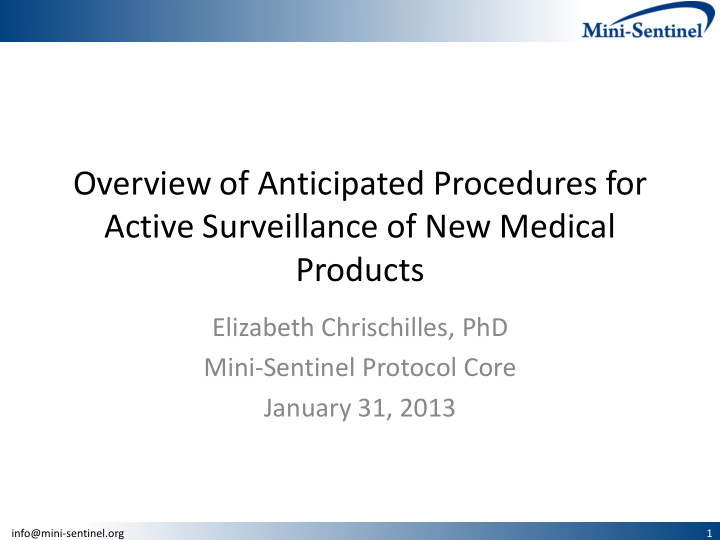



Overview of Anticipated Procedures for Active Surveillance of New Medical Products Elizabeth Chrischilles, PhD Mini-Sentinel Protocol Core January 31, 2013 info@mini-sentinel.org 1
Goal Relatively standardized Prospective Dozens of products simultaneously Signal potential excess risk for subsequent follow-up info@mini-sentinel.org 2
http://www.mini- sentinel.org/work_products/Assessments/Mini- Sentinel_Prospective-Surveillance-Statement-of-Work.pdf info@mini-sentinel.org 3
Prospective surveillance at a glance Newly marketed product Define exposures, outcomes, etc Choose analysis approach Estimate the risk Aggregate results over time Apply alerting rules Report to FDA FDA reports to public when appropriate info@mini-sentinel.org 4
Prospective surveillance: who, what, when Newly marketed product Define exposures, outcomes, etc • FDA: Product in need of surveillance • 6 mo prior to desired start • Planning team: • Which outcomes? • Post-exposure time window? • Which design? • Which data? • Plan for promptly evaluating signals? info@mini-sentinel.org 5
Standard outcome algorithms GI bleeding Systemic lupus erythematosis Pancreatitis Inflammatory Bowel Disease Premature delivery Juvenile RA Pulmonary Fibrosis Tuberculosis Hypertensive crisis Erythema multiforme major Agranulocytosis Idiopathic thrombocytopenic purpura Aplastic Anemia Thrombocytopenia Bronchospasm Henoch Schonlein purpura CVA Peripheral neuropathy Venous Thromboembolism Guillan-Barre syndrome Hemorrhagic CVA Tendon rupture Ischemic CVA Seizure, febrile Neutropenia Suicide Bell’s Palsy Valvulopathy Spontaneous abortion/Stillbirth Hip fracture Acute Respiratory Failure Pulmonary hypertension Sepsis Rhabdomyolysis Deafness Sudden cardiac death Thrombotic thrombocytopenic purpura Diabetes info@mini-sentinel.org 6
Standard Outcome Definitions: Outcome Algorithm Rationale Reference Acute Recommended Primary : Some algorithms also included 22262598 Ischemic 434, 436 in first position 433.x1 and excluded 434.x0 (see 12105309 Stroke of a hospital claim Recommended Secondary), however 433.x1 may also have low PPV and the PPV for 434 (without exclusion) in first position is good (>85%). PPV diminishes slightly when any position, or when community vs tertiary care. Algorithm that included 433.x1, 434 (excluding 434.x0), 22262598 Recommended Secondary : 433.x1, and 436 performed well. 433 (other than 433.x0) had very 12364739 434 (excluding 434.x0), 436 in first low PPV. One study found 433.x1 PPV=71% position of a hospital claim 433 had very low PPV . 433.x0 PPV was 2%, Also Observed (but not 9707200 recommended): 433, 434, 436 in first 433.x1 PPV was only 20% . position info@mini-sentinel.org 7
Prospective surveillance: how Newly marketed product Define exposures, outcomes, etc Choose analysis approach Cohort or self-controlled? Comparator? Who is eligible? Confounders? Relative risk? Risk difference? info@mini-sentinel.org 8
What affects the choice? Exposure-outcome characteristics info@mini-sentinel.org 9
Stakeholder preferences affect the choice info@mini-sentinel.org 10
Standard cohort algorithms Persons with coronary artery Nursing home residents • • disease Pregnant women • Persons with mood disorders Live births • • Persons with end-stage renal Premature babies • • disease Persons at high risk for influenza • Hypertensives complications • Smokers Immunocompromised persons • • Asthmatics • Type 1 diabetics • Persons with dementia Type 2 diabetics • • Persons who received Obese persons • • fluoroquinolones for post- exposure prophylaxis First responders • info@mini-sentinel.org 11
Recommend
More recommend